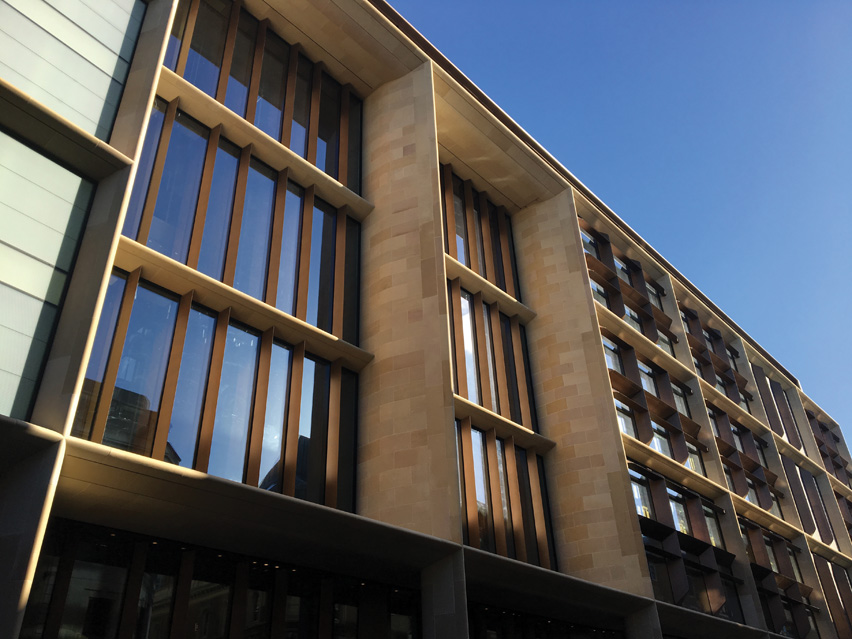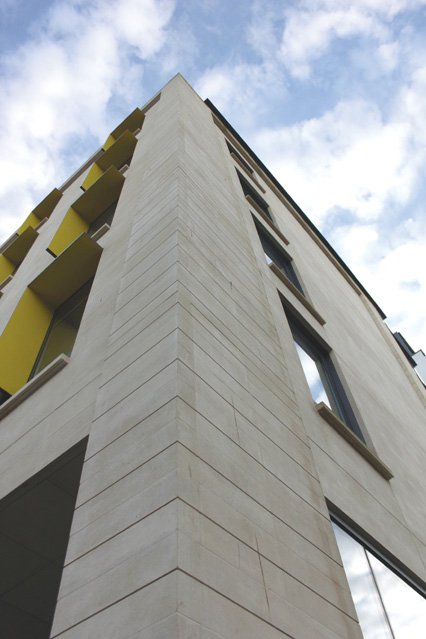Report: Stone cladding
To those working on fast track projects, the government’s complaint about a lack of productivity in construction might seem harsh. But the government is looking for innovation.
The fire at Grenfell Tower in London with its tragic consequences. Walls falling off new school buildings in Scotland. The financial collapse of the government’s pet builders, Carillion. They have all concentrated parliament’s collective mind because it is starting to look as if construction is in crisis.
With the industry contributing £100billion a year (give or take) to the national economy, any problems it has quickly become the nation’s problems. Which is why Dame Judith Hackitt is currently heading a review of the Building Regulations, which she has said are not fit for purpose; Lord Patel, who chairs the House of Lords Science & Technology Committee, is looking at offsite manufacturing in construction; and Parliament’s Business, Energy & Industrial Strategy Committee is looking at ways to change payment arrangements so specialist sub-contractors stop being the industry’s fall guys by not getting paid for work they have carried out.
Stone is not exempt from the issues affecting the whole of the construction industry, of course, and in its own parochial small corner it, too, has a review in place – of BS 8298, the standard for the design and installation of natural stone cladding. It is overdue. British standards are supposed to be reviewed every five years but it is eight years since BS 8298 was last amended. It will probably be another two years before the latest review results in another published revision.
In 2010, a significant change to the standard when it was last revised was in the way the thickness of stone used for cladding should be calculated. The idea was to allow thinner stone panels to be used as long as the stone was capable of withstanding the forces involved, which has to be verified.
BS 8298 comes in four parts (the new version will include a fifth on the use of interior stone lining). Buying all four parts costs £728 (£364 for BSI members). Part one is an overview, part two covers handset cladding, part three precast, and part four rainscreen and metal frames, so you might only need to buy part one and the section relevant to a particular job.
Because BS 8298 is quite complex and detailed, Stone Federation’s technical committee, some members of which were involved in the writing of the standard, produced a guide to it to give its members (but only its members) some useful suggestions for the correct use of stone as a cladding material. The guide is intended to be used in conjunction with the standard, not as a replacement for it.
Thinner stone means less stone, which, in turn, should mean lower prices. Thinner stone also reduces the weight of the cladding, which means the building supporting it does not have to be so strong.
That can produce more savings in materials used for the structure of the building on to which the cladding is fixed. Fixing systems do not have to be so strong, either – and the fixing systems, especially with ever thicker insulation to accommodate in order to meet energy saving targets, can be more expensive than the stone.
Throughout the construction industry, competition to win projects drives prices down. With necessity supposedly the mother of invention, the ideal resolution of lower prices is innovation. That should increase productivity and everyone ends up richer.
That has happened. Once the most common way of using stone cladding was by hand setting. That has not disappeared, but often alternative methods of fixing stone are used these days – stone on precast, for example, or thin stone veneers on backing panels of aluminium honeycomb or other materials. Stone is often fixed on metal frames, such as the Shackerley SureClad system used at The Point in London (see page 14), Generix from Taylor Maxwell or Fischer’s system, where undercut anchors drilled into the back of the stone panels are connected to a frame attached to the building.
Such systems can typically resist up to twice the pull out loads of traditional dowels and therefore mean the stone used can be thinner and lighter.
While innovation is the ideal solution to competition, sometimes the result is the less desirable cutting of corners – perhaps in design, testing, material selection or the build itself. Cutting corners is usually the first step towards failures.
In the interim findings of the review of Building Regulations published on 18 December, Dame Judith wrote: “There is plenty of good practice but it is not difficult to see how those who are inclined to take shortcuts can do so. Change control and quality assurance are poor throughout the process. What is initially designed is not what is being built, and quality assurance of materials and people is seriously lacking.”
The government believes the construction industry should be doing more to innovate and increase productivity, hence its review of the Building Regulations, Lord Patel’s investigation into off-site manufacturing. and the review of BS 8298.
 Catcastle Buff sandstone from Dunhouse on the National Library of Scotland.
Catcastle Buff sandstone from Dunhouse on the National Library of Scotland.
 Cove Red sandstone from Blockstone on Scotch College, Melbourne.
Cove Red sandstone from Blockstone on Scotch College, Melbourne.
 Portland limestone from Albion Stone in London.
Portland limestone from Albion Stone in London.
 Stanton Moor sandstone from Marshalls on the Bloomberg building in London.
Stanton Moor sandstone from Marshalls on the Bloomberg building in London.
The projects pictured above show why architects and clients want to use stone cladding – it really would be hard to find an alternative material that can give a building such gravitas, stature and, yes, beauty.
Yet the National Library of Scotland at the top is also a case study of finding the right stone. It was originally clad in Newbigging sandstone from a quarry near Burntisland in Fife that was re-opened in 1984 especially to provide stone for this building. It proved to be a costly mistake because it was not durable enough to cope with the award winning design with its large slopes and none of the string courses, cills or other features that on a traditional design throw water away from the face. The stone decayed and has now been replaced with Catcastle Buff, supplied by Dunhouse Quarries from its quarry near Blackburn in Lancashire. Catcastle is less porous and more durable than Newbigging sandstone.
Not much British stone is exported because the geology of the British Isles makes winning its stones more difficult than it is to extract stones in some other parts of the world. Nevertheless, that geology also gives its stones a certain distinction, which can be just what is required, as it was with Blockstone’s Cove Red sandstone chosen for the Sir Zelman Cowen Centre for Science at Scotch College in Melbourne, Australia, where the design included fins of the stone shaped to form a sine wave.
Portland limestone has the advantage in London of having been the stone chosen for the city’s rebuilding after The Great Fire in 1666, but it is not the only stone used, as the cladding of the Bloomberg building in Marshall’s Stanton Moor stone demonstrates.

